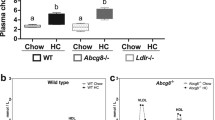Abstract
The lactating human mammary gland and the pancreas both produce bile salt-stimulated lipase (BSSL), a lipolytic enzyme acting on a wide range of substrates, including triglyceride, cholesterol esters, and fat-soluble vitamins esters. Breast milk BSSL has a particularly important role in the digestion of milk fat by newborn infants. We report the generation of transgenic mice that harbored a human BSSL gene controlled by a mammary gland-specific promoter. BSSL levels in transgenic mouse milk were raised to 376.8 μg/ml, corresponding to an activity of 9.15 U/ml. Premature wild-type neonates nursed by transgenic dams exhibited significantly higher survival rate than did the control neonates nursed by wild dams (95 vs. 83.3 % and, P < 0.05). They also showed 43.8 % greater body weight gain and 33.3 % lesser fecal crude fat levels than did the controls. This study provides significant evidence that increased levels of BSSL in milk may reduce mortality and improve the growth and fat absorption in premature mice during neonatal development.








Similar content being viewed by others
References
Herrera, E., & Amusquivar, E. (2000). Lipid metabolism in the fetus and the newborn. Diabetes/Metabolism Research and Reviews, 16(3), 202–210.
Stromqvist, M., Tornell, J., Edlund, M., Edlund, A., Johansson, T., Lindgren, K., et al. (1996). Recombinant human bile salt-stimulated lipase: An example of defective O-glycosylation of a protein produced in milk of transgenic mice. Transgenic Research, 5(6), 475–485.
Hamosh, M. (1987). Lipid metabolism in premature infants. Biology of the Neonate, 52(Suppl 1), 50–64.
Hui, D. Y., & Howles, P. N. (2002). Carboxyl ester lipase: Structure–function relationship and physiological role in lipoprotein metabolism and atherosclerosis. Journal of Lipid Research, 43(12), 2017–2030.
Howles, P. N., Stemmerman, G. N., Fenoglio-Preiser, C. M., & Hui, D. Y. (1999). Carboxyl ester lipase activity in milk prevents fat-derived intestinal injury in neonatal mice. American Journal of Physiology, 277(3 Pt 1), G653–G661.
Bläckberg, L., Duan, R. D., & Sternby, B. (1997). Purification of carboxyl ester lipase (bile salt-stimulated lipase) from human milk and pancreas. Methods in Enzymology, 284, 185–194.
Sahasrabudhe, A. V., Solapure, S. M., Khurana, R., Suryanarayan, V., Ravishankar, S., deSousa, S. M., et al. (1998). Production of recombinant human bile salt stimulated lipase and its variant in Pichia pastoris. Protein Expression and Purification, 14(3), 425–433.
Poorkhalkali, N., Lidmer, A. S., Lundberg, L. G., Dalrymple, M. A., Gibson, Y., Taylor, L., et al. (1998). Bile salt-stimulated lipase (BSSL) distribution in rat, mouse and transgenic mouse expressing human BSSL. Histochemistry and Cell Biology, 110(4), 367–376.
Howles, P. N., Carter, C. P., & Hui, D. Y. (1996). Dietary free and esterified cholesterol absorption in cholesterol esterase (bile salt-stimulated lipase) gene-targeted mice. Journal of Biological Chemistry, 271(12), 7196–7202.
Weng, W., Li, L., van Bennekum, A. M., Potter, S. H., Harrison, E. H., Blaner, W. S., et al. (1999). Intestinal absorption of dietary cholesteryl ester is decreased but retinyl ester absorption is normal in carboxyl ester lipase knockout mice. Biochemistry, 38(13), 4143–4149.
Loctin, J., & Delost, P. (1983). Somatic development in premature mice from birth to weaning. Reproduction, Nutrition, Development, 23(5), 915–926.
Hernell, O., & Olivecrona, T. (1974). Human milk lipases. I. Serum stimulated lipase. Journal of Lipid Research, 15(4), 367–374.
Yu, S., Liang, M., Fan, B., Xu, H., Li, C., Zhang, Q., et al. (2006). Maternally derived recombinant human anti-hantavirus monoclonal antibodies are transferred to mouse offspring during lactation and neutralize virus in vitro. Journal of Virology, 80(8), 4183–4186.
Zhang, R., Rao, M., Li, C., Cao, J., Meng, Q., Zheng, M., et al. (2009). Functional recombinant human anti-HAV antibody expressed in milk of transgenic mice. Transgenic Research, 18(3), 445–453.
Wang, Y., Tong, J., Li, S., Zhang, R., Chen, L., Wang, Y., et al. (2011). Over-expression of human lipoprotein lipase in mouse mammary glands leads to reduction of milk triglyceride and delayed growth of suckling pups. PLoS ONE, 6(6), e20895.
Miller, R., & Lowe, M. E. (2008). Carboxyl ester lipase from either mother’s milk or the pancreas is required for efficient dietary triglyceride digestion in suckling mice. Journal of Nutrition, 138(5), 927–930.
Lombardo, D. (2001). Bile salt-dependent lipase: Its pathophysiological implications. Biochimica et Biophysica Acta, 1533(1), 1–28.
Andersson, E. L., Hernell, O., Blackberg, L., Falt, H., & Lindquist, S. (2011). Bile salt-stimulated lipase and pancreatic lipase-related protein 2: Key enzymes for lipid digestion in the newborn examined using the Caco-2 cell line. Journal of Lipid Research, 52(11), 1949–1956.
Wang, C. S., Martindale, M. E., King, M. M., & Tang, J. (1989). Bile-salt-activated lipase: Effect on kitten growth rate. American Journal of Clinical Nutrition, 49(3), 457–463.
Li, X., Lindquist, S., Lowe, M., Noppa, L., & Hernell, O. (2007). Bile salt-stimulated lipase and pancreatic lipase-related protein 2 are the dominating lipases in neonatal fat digestion in mice and rats. Pediatric Research, 62(5), 537–541.
Pamblanco, M., Ten, A., & Comin, J. (1987). Bile salt-stimulated lipase activity in human colostrum from mothers of infants of different gestational age and birthweight. Acta Paediatrica Scand, 76(2), 328–331.
Acknowledgments
This work was supported by National Transgenic Breeding Program of China (2009ZX08007-001B) and (2009ZX08009-139B), Bengbu Medical College (Bykf13A01), and Funds for Distinguished Young Scholar of Anhui Province, China (2013SQRL050ZD).
Author information
Authors and Affiliations
Corresponding author
Additional information
Yuanyuan Wang and Zheya Sheng have contributed equally to this work.
Rights and permissions
About this article
Cite this article
Wang, Y., Sheng, Z., Wang, Y. et al. Transgenic Mouse Milk Expressing Human Bile Salt-Stimulated Lipase Improves the Survival and Growth Status of Premature Mice. Mol Biotechnol 57, 287–297 (2015). https://doi.org/10.1007/s12033-014-9822-5
Published:
Issue Date:
DOI: https://doi.org/10.1007/s12033-014-9822-5




